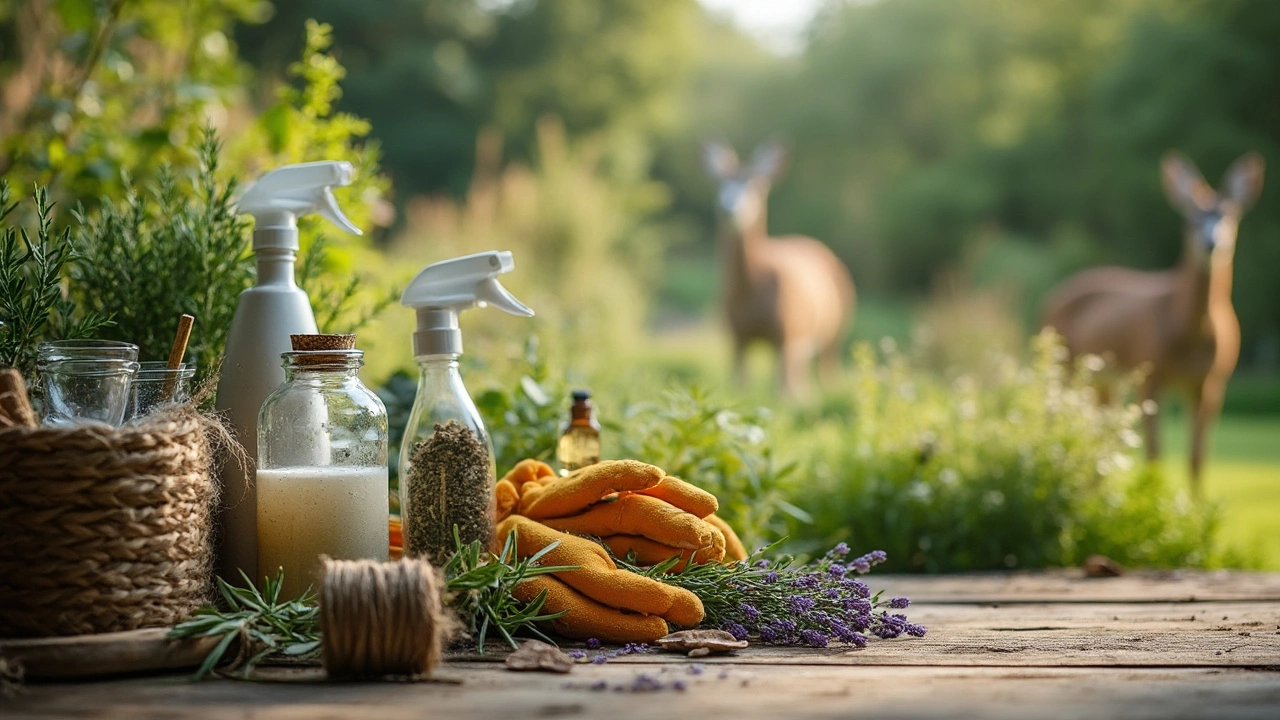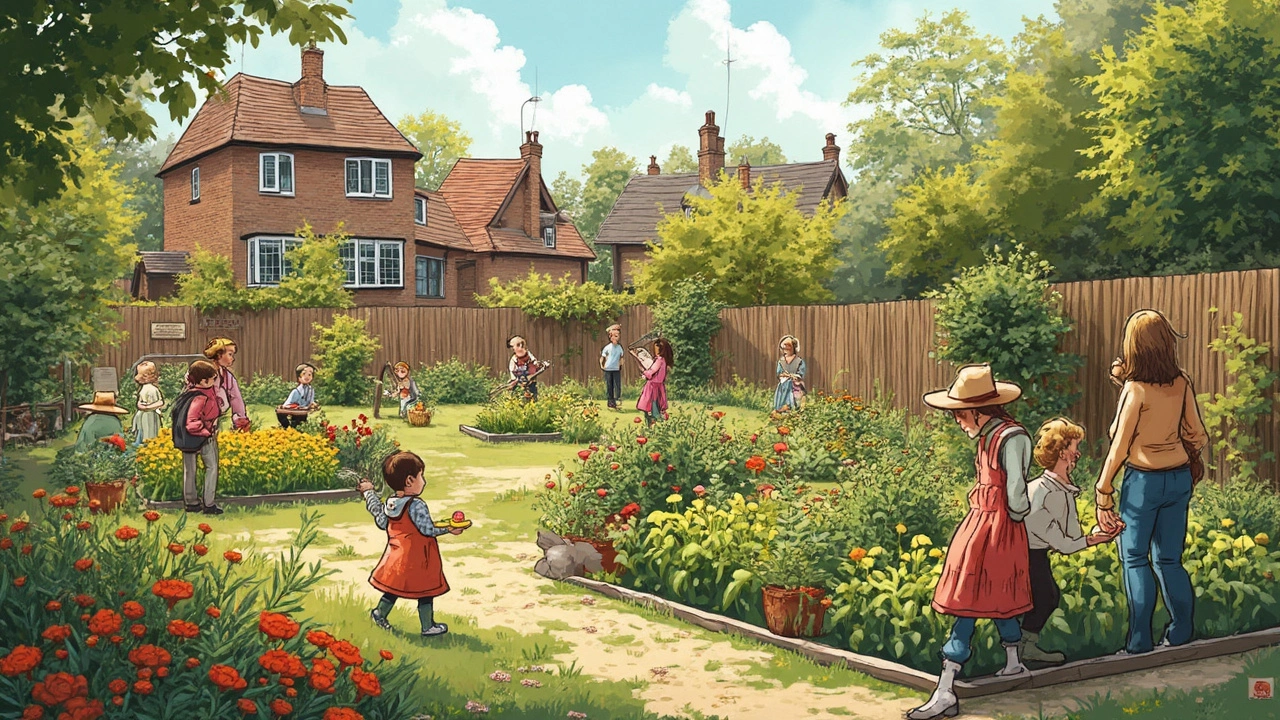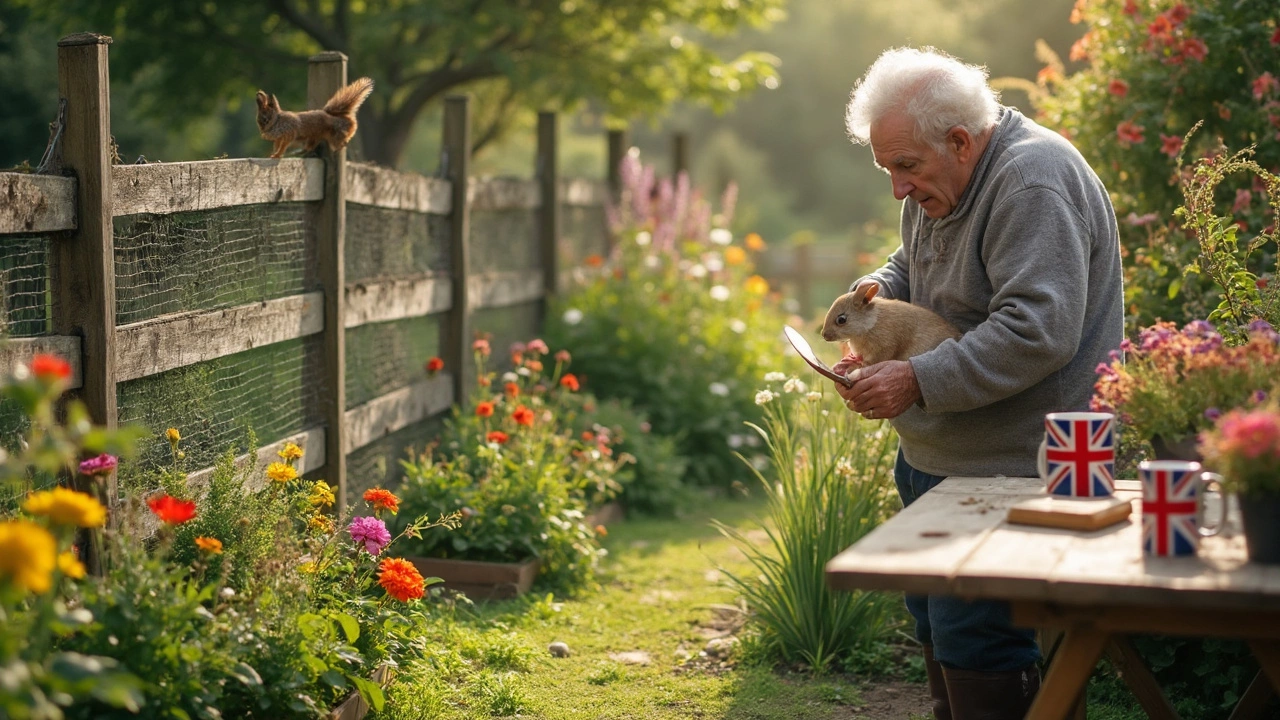If you’re tired of waking up to chewed leaves and half-eaten tomatoes, you’re not alone. Animals see your garden as an all-you-can-eat buffet. Rabbits dig in like it’s their job, deer aren’t shy about mowing down entire rows, and squirrels love digging up fresh seeds. Protecting your garden starts with figuring out which animals are causing trouble. Tracks, droppings, and bite marks can give you real clues, and knowing their habits helps you outsmart them.
The quickest win? Put up barriers. Even a simple wire fence can throw off most rabbits and keep dogs out too. Stretch chicken wire at least two feet high and bend the bottom an inch or two outward—rabbits love to dig. For deer, you’ll need something taller, like a six-foot fence or angled mesh. Netting works for small critters and birds but make sure it’s tight or animals might just scoot under.
- Know Your Enemies: Spotting Common Animal Invaders
- Physical Barriers: Fences, Netting, and Beyond
- Natural Deterrents That Actually Work
- Making Your Garden Less Appealing
- Maintenance and Staying One Step Ahead
Know Your Enemies: Spotting Common Animal Invaders
It’s easy to blame ‘pests’ for every hole or missing leaf, but different animals actually leave their own trademark signs. Knowing exactly what’s sneaking snacks from your backyard gives you a solid head start when it comes to picking the right defense.
The most common culprits in North American gardens include rabbits, deer, squirrels, raccoons, groundhogs, and birds. Each one has a preference, a pattern, and a different way of getting around fences or netting. To catch them in the act—don’t just look, learn their calling cards. Here’s how common visitors show up:
- Deer: Look for plants with torn and ragged edges or stems pulled off. Hoof prints around the garden are a giveaway.
- Rabbits: Clip leaves clean, close to the ground. You’ll also spot round pellets and maybe tiny dug-out spots at fence lines.
- Squirrels: Dig up bulbs and seeds, and leave half-eaten fruits behind. Their teeth marks are usually small and neat.
- Raccoons: Often tip over trash and break corn stalks. Messy feeders, they’ll use paws to grab and pull.
- Groundhogs (woodchucks): Leave big bite marks, low to the ground. Holes at the edge of the garden? That’s them.
- Birds: Peck at fruit, especially berries and tomatoes, and can strip a plant bare.
Dr. Carla Emerson, a wildlife ecologist, says:
"Correctly identifying the animal is the most important step if you want real results. Each pest has its weakness—and recognizing their patterns makes control much easier."
Here’s a quick lookup table on garden signs:
| Animal | What to Look For | Active Time |
|---|---|---|
| Deer | Ragged leaves, hoof prints | Night/Dawn |
| Rabbits | Clean snips on stems, droppings | Early morning/evening |
| Squirrels | Dug-up soil, small bite marks | Daytime |
| Raccoons | Trampled plants, scattered food | Night |
| Groundhogs | Low big bites, burrow entrances | Daytime |
| Birds | Pecked fruit, stripped plants | Daytime |
Knowing your invader sets you up to make your garden pest control finally pay off. Start with tracks, bite marks, and timing, then put your money and energy into what blocks the real problem—not just any critter that wanders by.
Physical Barriers: Fences, Netting, and Beyond
The fastest way to block most pests? Good old-fashioned barriers. Sure, it sounds simple, but a well-placed fence or netting can save you big headaches down the road. Choosing the right barrier depends on who’s crashing your garden party.
Garden pest control really kicks off with a fence. For rabbits, chicken wire is the gold standard—get something at least 2 feet tall and bend it outward at the bottom to stop burrowers. Squirrels and chipmunks are nimble climbers, so focus on tight mesh (no bigger than half an inch) and bury it at least 6 inches underground. Deer are the heavyweights—they’ll clear a 5-foot fence like it’s nothing, so either go up to 8 feet or slant the fence outward to mess with their sense of jumping distance.
- Wire or Welded Fencing: Great for rabbits, groundhogs, and armadillos. Opt for 16-gauge wire for durability. Bury 6-12 inches deep.
- Plastic Mesh: Easy to install for small gardens. Won’t stop bigger critters but good for birds and squirrels if you keep it taut.
- Electric Fencing: A last resort for deer and raccoons. Use with care—most garden supply stores offer low-voltage kits that are pet- and kid-safe when set up right.
- Row Covers and Crop Cages: Simple nets draped over rows keep cabbage moths and birds off your plants. Weigh down with rocks or anchor pins—wind loves to steal netting.
Ready for some quick numbers? Check out how effective different barriers are against common animals:
| Barrier Type | Best For | Average Success Rate |
|---|---|---|
| Wire Fence (2ft for rabbits) | Rabbits, groundhogs | 90% |
| Electric Fence (properly set) | Deer, raccoons | 95% |
| Plastic Mesh Netting | Birds, squirrels | 80% |
| Row Covers | Caterpillars, birds | 85% |
Don’t forget the little things—check your barriers each week for damage or holes. Animals will squeeze into the tiniest gap if given half a chance. Keep that fence snug, netting tight, and stakes solid. For extra peace of mind, clip shiny objects onto fences to spook cautious deer or add scent-based repellents nearby for double duty.

Natural Deterrents That Actually Work
Forget those expensive sprays that promise the world and deliver nothing. Let’s talk about natural tricks and homemade fixes that gardeners actually use to keep animals out. Most garden pests follow their noses—so if something smells weird or strong, they’ll usually give your veggies a hard pass.
Plants like marigolds, garlic, and onions give off scents that deer and rabbits can’t stand. Mixing them in with your vegetables creates a natural wall of stink that’s way cheaper than store-bought repellents. If you have extra peppermint oil laying around, mix it with water and spray it on the leaves. It bothers smaller critters like mice and squirrels, and it doesn’t hurt the plants.
Don’t toss your coffee grounds or grated soap scraps, either. Sprinkle those right on the soil—they can deter cats, slugs, and even some rodents. Same goes for crushed eggshells. The sharp edges make soft-bellied visitors like slugs and snails regret their life choices.
- Try a garlic-chili pepper spray: Blend a head of garlic, a hot pepper, and two cups of water. Strain and spray the mixture onto plant leaves every few days, especially after it rains.
- Hang shiny objects like old CDs or aluminum pie pans from branches. The flashes of light spook birds and squirrels, keeping them from treating your garden like a free snack bar.
- For something low effort, install a motion-activated sprinkler. It’s friendly to animals but gives them a wet surprise so they learn to avoid the area.
Here’s the deal: none of these tricks are perfect on their own. You usually need a mix of these methods to truly make your garden animal proof. Rotate your deterrents every few weeks so the animals don’t get used to them. Once they associate your yard with weird smells, sounds, or surprises, they’re more likely to move on to someone else’s tomatoes.
Making Your Garden Less Appealing
Most critters go where the food is easy. If your garden is the tastiest spot in the neighborhood, you're basically rolling out the red carpet to every rabbit, deer, and raccoon. The trick? Make your space less inviting. There are simple, proven ways to do this without harming your plants or the animals. The big idea is to change how your garden looks, smells, and even feels to these backyard bandits.
Start with gardening habits. Clear out any fallen fruit, nuts, or leftover veggies fast—these are magnets for rodents and bigger animals too. Compost bins should be locked up and away from the garden’s edge. If bird feeders are around, hang them away from your vegetable patch, since spilled seed brings in more than just birds.
Certain plants seriously turn animals off. For example, marigolds and lavender send deer and rabbits packing because of their strong smell. Spiky, hairy, or fuzzy leaves—think lamb’s ear or yarrow—also help. It’s no myth; researchers at Cornell University found that deer are much less likely to nibble pungent or textured plants. You can use these as a kind of living “moat” around your favorite crops.
“Choose plants with a reputation for resisting browsing and plant them on the border of your more vulnerable crops,” says Dr. Jason Jordan from the National Center for Home Food Gardening.
Animals love easy access, so keep things neat. Tall grass, wood piles, and thick mulch offer hiding places, especially for rabbits and rats. Mow, trim, and tidy up regularly. Motion-activated lights or sprinklers sometimes scare off sneaky nighttime visitors.
- Clean up fallen fruit and veggies right away
- Use strong-smelling or fuzzy plants as deterrents along edges
- Keep compost contained and secure
- Hang bird feeders far from the garden
- Avoid dense brush or wood piles near crops
This stuff isn’t just guesswork. Check out this quick snapshot of what really works, based on a survey of over 1,200 home gardeners by the University of Wisconsin Extension:
| Deterrent | Reported Success Rate (%) |
|---|---|
| Cleaning Up Fallen Produce | 78 |
| Planting Marigolds/Lavender Borders | 64 |
| Motion-Activated Sprinklers | 57 |
| Mid-Season Garden Tidy-Up | 72 |
If you want a truly animal proof garden, don’t just focus on fences—stack the odds by making your yard as uninviting as possible. Animals like things quiet, messy, and snack-filled. Take that away, and they’ll move to easier pickings next time.

Maintenance and Staying One Step Ahead
Even the best defenses break down if you ignore them. Animals come back, try new tricks, and weather can wear down barriers. That’s why routine maintenance is such a big deal for anyone serious about garden pest control. Those fences, nets, and gadgets you set up at the start of spring? Give them a hard look every couple of weeks. Check for holes, sagging pieces, or spots where animals pushed through. Squirrels and rabbits especially are determined little escape artists.
Switching up your methods keeps animals guessing. If you use sprays or repellents, rotate them or try something new each season. In a study from the University of Nebraska, alternating scents and tastes cut animal visits by about 35%, versus sticking with one strategy all year.
Here’s what regular garden check-ups can look like:
- Walk the perimeter and inspect fences/netting for gaps every two weeks.
- Freshen up repellents after rain or watering.
- Rake or smooth soft soil to spot new footprints or tunnels.
- Remove dropped fruit or vegetables that might tempt pests.
- Prune overhanging branches—these can be fast tracks for squirrels and raccoons.
If you notice a sudden uptick in animal activity, try re-applying scent repellents, patching weak spots, or moving scare devices like fake owls to new locations. Animal brains aren’t as simple as we think—switching things up can make a real difference.
"Every season brings new challenges. What works for deer in May might not faze them in August. Stay flexible and pay attention—it’s the only way to stay ahead."
— Dr. Matt Geisler, Wildlife Specialist, University of Illinois Extension
If you want a quick look at how often folks deal with animal break-ins, check out these numbers from a 2024 gardening survey:
| How Often Gardeners Spot Animal Damage | Percent of Gardeners |
|---|---|
| Every Week | 48% |
| Once a Month | 31% |
| Every Few Months | 16% |
| Rarely | 5% |
The takeaway: Don’t just set it and forget it. Routine checks and tweaks will save you more crops than any single quick fix. Keep an eye out, be willing to adapt, and you’ll stay a step ahead of hungry visitors.
